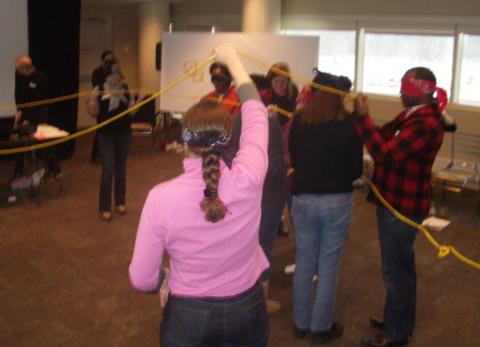As often as I balk at prescriptive approaches to creating playspace, I am asked for examples of how others are doing it in their organizations. Below is a short list of innovative approaches from a wide range of organizations. Some are from “From Workplace to Playspace,” others I have heard from workshop participants and readers around the country. I hope that you will be inspired and “get permission” from them to experiment with approaches that fit for your organization.

1) Warm-up Your Day. Umpqua Bank, a thriving regional community bank, featured in the book, begins every day across its more than 175 locations with something CEO, Ray Davis calls a “Motivational Moment.” Every single employee gathers in the lobby at each location to join in a group activity to boost their energy and enthusiasm for the day. Anyone can lead the session, and the only guidelines are that it cannot be political or religious in nature. This means that Umpqua associates start their day singing, dancing, improvising, playing games such as Marshmallow Dodge Ball and generally building the camaraderie, good will and focus that has landed them on Fortune’s 100 Best Companies to Work For list the last four years in a row.
2) Warm-up Your Meeting. Research shows that people are more creative if they engage in some sort of light-hearted creative activity before they take on a new challenge (Conti, Amabile, & Pollack, 1995). Anything from 60 seconds of Be. Here. Now. time (see demonstration video) to engaging in a brainstorm about how to solve some seemingly impossible challenge (e.g. How can we eliminate world hunger? How can we become a totally paperless office? How can we use migrating birds to deliver our communications?), the more outlandish, silly and/or impossible the challenge, the better.
3) Argue a Different Point of View. Skilled debate teams regularly switch sides to become more adept at their craft. You can build your team’s critical thinking skills in a similar way. If you see a passionate debate come to a deadlock, ask the key proponents from each side to argue for another option. Ask others to list the pros and cons as they emerge. This is also an effective strategy if everyone seems to be getting cozy with one point of view. Step back and ask people to argue for the opposite view, or for a point of view that is not represented in the room (e.g. Play the role of the front-line worker, customer, student, child, non-English-speaking immigrant, senior citizen). What new possibilities emerge when you consider the other side? Are there ways to take these concerns into consideration?
4) Play. There are endless lists of games and contests that can bring more play (as in flexibility) in the system, levity, build relationships and open up more space for possibilities. Some of my favorites include Google’s “Pimp My Cubicle” Contest, and various guessing contests, such as those inviting employees to match baby pictures, hobbies, or pet photos with their owners. These have significant value in getting people to connect outside of their formal roles and responsibilities, which goes a long way in building relationships and social capital—that enhance collaboration and resource sharing.
5) Say, “Yes, and . . .” Anyone who has taken a basic improv class (or attended one of my playspace sessions) knows that “Yes, and . . .” is the secret to successful collaboration and idea generation. It is also key to making space for more possibilities. It simply means that we replace the word “but” with the word “and” and look for every opportunity to build on our colleagues’ ideas. Saying “yes” does not mean we are going to implement every idea, simply that we are willing to explore its possibilities. Most innovative solutions began as crazy impractical ideas that benefited from some generous “yes, and-ing.” Take it for a test drive and let me know how it worked for you!
This list is just a start. Please post your ideas for making more space for the play of new ideas and perspectives in the comment section below!
— Conti, R., Amabile, T. M., & Pollack, S. (1995). The positive impact of creative activity: Effects of creative task engagement and motivational focus on college students’ learning. Personality and Social Psychology Bulletin, 21, 1107–1116.
